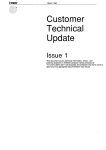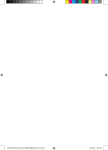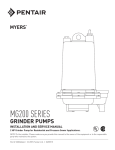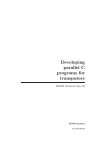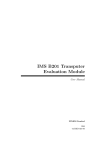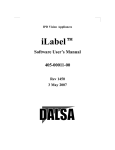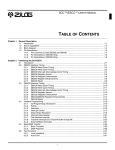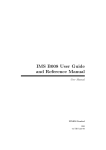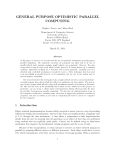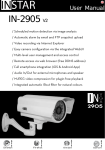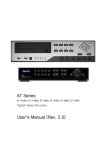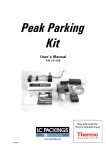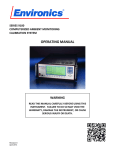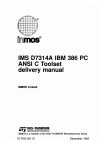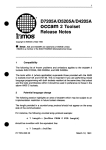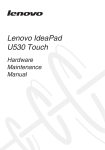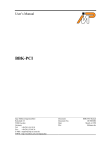Download IMS D7214C/D5214B/D4214B ANSI C toolset
Transcript
..~
~
.•
DJ
omriios®
IMS
D4214B,D5214B,D7214C
ANSI C toolset
Release Notes
READ THIS FIRST
~ SGS-1HOMSON
Ill.~ ® ~D©OO@~~©iiOO@~[]©$
I
INMOS is a member of the SGS-THOMSON Microelectronics Group
72 TDS 293 00
May 1991
Copyright © INMOS Limited 1991. This document may not be copied, in whole or
in part, without prior written consent of INMOS.
The C compiler implementation was developed from the Perihelion Software ·C"
Compiler and the Codemist Norcroft "C" Compiler.
e®, DDllmo8 ®, IMS and occam are trademarks of INMOS Limited.
INMOS is a member of the SGS-THOMSON Microelectronics Group.
INMOS Document Number: 72 TDS 293 00
72 TDS 293 00
May 1991
I Contents
1
2
Introduction. . . . . . . . . . . . . . . . . . . . . . . . . . . . . . . . . . . .
1
1.1
1.2
Changes to the product. . . . . . . . . . . . . . . . . . . . . . . . . . . . .
Validation . . . . . . . . . . . . . . . . . . . . . . . . . . . . . . . . . . . . . . . .
1
1
Changes from previous release . . . . . . . . . . . . . . . . . . . .
3
2.1
2.2
General additions to the product. . . . . . . . . . . . . . . . . . . . . .
Changes to tools and libraries. . . . . . . . . . . . . . . . . . . . . . . .
2.2.1
Changes to the ANSI C compiler ice
Additions.....
.. .. .
. .. . . ..
.
Enhancements . . . . . . . . . . . . . . . . . . . . . . . . . . . .
Bugs Fixed . . . . . . . . . . . . . . . . . . . . . . . . . . . . . . .
2.2.2
Changes to the ANSI C Libraries . . . . . . . . . . . . . .
Bugs Fixed . . . . . . . . . . . . . . . . . . . . . . . . . . . . . . .
2.2.3
Changes to the linker ilink
Additions . . . . . . . . . . . . . . . . . . . . . . . . . . . . . . . . .
2.2.4
Changes to the configurer icconf . . . . . . . . . . . . . .
Enhancements . . . . . . . . . . . . . . . . . . . . . . . . . . . .
Bugs Fixed . . . ... . . . . . . . . . . . . . . . . . . . . . . . . . .
2.2.5
Changes to the collector icollect . . . . . . .... . . . . . . .
Additions . . . . . . . . . . . . . . . . . . . . . . . . . . . . . . . . .
Enhancements. . . . . . . ... . . . . . . . . . . . . . . . . . . .
Bugs Fixed . . . . . . . . . . . . . . . . . . . . . . . . . . . . . . .
2.2.6
Changes to the debugger idebug . . . . . . . . . . . . . .
Command Line Options. . . . . . . . . . . . . . . . . . . . .
Monitor page
INSPECT I MODIFY Expressions
Error Messages
Miscellaneous. . . . . . . . . . . . . . . . . . . . . . . . . . . . .
Bugs Fixed . . . . . . . . . . . . . . . . . . . . . . . . . . . . . . .
Documentation Omissions . . . . . . . . . . . . . . . . . . .
2.2.7
Changes to the Makefile generator imakef
Additions . . . . . . . . . . . . . . . . . . . . . . . . . . . . . . . . .
Enhancements. . . . . . . . . . . . . . . . . . . . . . . . . . . .
2.2.8
Changes to the T425 simulator isim . . . . . . . . . . . .
Additions . . . . . . . . . . . . . . . . . . . . . . . . . . . . . . . . .
Bugs Fixed . . . . . . . . . . . . . . . . . . . . . . . . . . . . . . .
2.2.9
Changes to the EPROM program converter ieprom
2.2.10 Changes to the processor skipping program iskip .
2.2.11
Changes to the host file server iserver. . . . . . . . . .
Enhancements ... . . . . . . . . . . . . . . . . . . . . . . . . .
Bugs Fixed .. . . . . . . . . . . . . . . . . . . . . . . . . . . . . .
2.2.12 Changes to other tools. . . . . . . . . . . . . . . . . . . . . .
3
3
3
3
4
4
6
6
7
7
8
8
9
10
10
10
10
11
11
12
12
14
14
15
15
16
16
16
16
16
16
17
17
17
17
17
18
ii
Contents
2.3
3
18
18
Installation. . . . . . . . . . . . . . . . . . . . . . . . . . . . . . . . . . . . .
21
3.1
21
21
21
21
21
22
22
22
22
3.2
4
NEC PC specific changes
2.3.1
New keyboard layout
Introduction. . . . . . . . . . . . . . . . . . . . . . . . . . . . . . . . . . . . . .
3.1.1
If you are replacing an existing ANSI C toolset ...
3.1.2
If you are using C and occam toolsets together . . .
3.1.3
Installing the iserver . . . . . . . . . . . . . . . . . . . . . . . .
3.1.4
Transputer hosted tools
3.1.5
New and changed directories
Server installation . . . . . . . . . . . . . . . . . . . . . . .. . . . . . . . . . .
3.2.1
PC server
3.2.2
Sun 3/Sun 4 servers . . . . . . . . . . . . . . . . . . . . . . . .
Errata.........................................
23
4.1
4.2
23
24
24
26
26
26
27
27
27
27
27
27
30
4.3
General. . . . . . . . . . . . . . . . . . . . . . . . . . . . . . . . . . . . . . . ..
Tools and libraries
4.2.1
ice . . . . . . . . . . . . . . . . . . . . . . . . . . . . . . . . . . . . . .
4.2.2
C libraries
4.2.3
icconf. . . . . . . . . . . . . . . . . . . . . . . . . . . . . . . . . . .
4.2.4
icollect . . . . . . . . . . . . . . . . . . . . . . . . . . . . . . . . . . .
4.2.5
imakef . . . . . . . . . . . . . . . . . . . . . . . . . . . . . . . . . ..
4.2.6
isim. . . . . . . . . . . . . . . . . . . . . . . . . . . . . . . . . . . . .
4.2.7
iemit. . . . . . . . . . . . . . . . . . . . . . . . . . . . . . . . . . . .
4.2.8
iserver . . . . . . . . . . . . . . . . . . . . . . . . . . . . . . . . . . .
Documentation errors
4.3.1
Reference Manual
4.3.2
User Manual .. . . . . . . . . . . . . . . . . . . . . . . . . . . . .
Appendices . . . . . . . . . . . . . . . . . . . . . . . . . . . . . . . . . . . . . . . .
33
A
Distribution kit. . . . . . . . . . . . . . . . . . . . . . . . . . . . . . . . . .
35
A.1
35
B
Differences in directory contents lists . . . . . . . . . . . . . . . . . . .
A.1.1
Differences for D42148 and D52148 from D4214A
and D5214A
Directories removed
Directories added
A.1.2
Differences for D7214C from D72148
Directory structure
NEC directory removed
Distribution kit . . . . . . . . . . . . . . . . . . . . . . . . . . . . .
35
35
35
36
36
36
36
ispy program . . . . . . . . . . . . . . . . . . . . . . . . . . . . . . . . . . .
39
8.1
39
Network worm - ispy
iii
Contents
8.1.1
C
Explanation of output . . . . . . . . . . . . . . . . . . . . . . .
40
Multibyte functions
41
C.1
C.2
C.3
41
41
42
42
43
44
45
46
Introduction. . . . . . . . . . . . . . . . . . . . . . . . . . . . . . . . . . . . . .
Implementation. . . . . . . . . . . . . . . . . . . . . . . . . . . . . . . . . . .
List of functions
mblen
mbstowcs . . . . . . . . . . . . . . . . . . . . . . . . . . . . . . . .
mbtowc
wcstombs .. . . . . . . . . . . . . . . . . . . . . . . . . . . . . . .
wctomb
iv
Contents
1 Introduction
This version of the INMOS ANSI C toolset is an update on the IMS D4214A,
05214A and 072148 products. As such, the documentation is the same as for
those toolsets, but you should read the following notes to see what changes have
been made.
1.1
Changes to the product
There are some general additions and enhancements to the product, some
changes to the tools and libraries, and some changes in the installation directories,
compared to the previous release. This release also includes bug fixes.
General changes and additions to the product are described in section 2.1.
Changes to the tools and libraries are described in section 2.2.
Changes to the installation directories are described in Appendix A.
Changes to the installation procedures, including installation of the iserver, are described in Chapter 3.
NEC specific changes are described in sections 2.3 and A.1.2.
Known problems in this release are described in Chapter 4.
1.2
Validation
The earlier versions of the INMOS ANSI C toolset were validated in 1990 against
release 2 of the Plum-Hall validation suite. The validation was done by the British
Standards Institute (BSI).
This maintenance release has not yet received a validation certificate. However,
INMOS claims that this version of the toolset passes all ofthe tests in the Plum-Hall
suite version 2.
This release also passes level 2.01, the first release of the 1991 BSI validation
suite. Full validation against the 1991 suite is expected in August 1991, on the anniversary of the original validation.
72TOS 293 00
May 1991
2
72TDS 293 00
May 1991
3
2 Changes from
previous release
This chapter describes the changes in this maintenance release from the ANSI C
toolsets 04214A, 05214A, and 072148.
Where appropriate, INMOS reference numbers are given for bugs fixed, in the format TSlnnn.
2.1
General additions to the product
• A program called ispy is included in the 07214C. This enables networks
of transputers to be examined and reset cleanly. Information for the user
is included in Appendix 8 of this document.
• The source of the driver program is included in 07214C. This was an omission in earlier versions of the product.
• The source of the user bootstrap is now found in the examples directory.
This was omitted from earlier versions of the product.
• The debugger better supports C++ (IMS D4217A, 05217A and 07217A).
2.2
Changes to tools and libraries.
2.2.1
Changes to the ANSI C compiler ice
Additions
• New option P mapfile
The compiler may be instructed, via the P mapfile option, to produce a map
of workspace for each function defined in the file, and a map of the static
area of the whole file. This map is written to the file mapfile.
For each function definition, a list of all local variables and formal parameters, and their position in the functions workspace is produced. The workspace requirement of the function is also listed; but note that this does not
take into account any extra 'below workspace' slots required for input, output, alternation or calls.
Local variables are listed in the order in which they are allocated in workspace, not the order in which they are declared.
For the whole file, a list of all the static variables and their position in the
file's static area is produced. The total static data requirement for the file
is also listed.
72 TOS 293 00
May 1991
4
Those static items which are globally visible are marked (global).
Static items introduced to allow the code to access external objects are
marked pointer to external object.
Static items whose name has been modified by the 1MB translate
pragma are listed under the name that is put into the object fiie, but are annotated with the message: (translated from sourcename) , where
sourcename is the name used in the source file.
• New option FS
The compiler has a new command line option (FS), which directs it to treat
right-shifts of signed integers as arithmetic shifts. The default behaviour is,
as before, to treat such shifts as logical shifts. This allows correct working
of some non-ANSI conforming programs which assume that right shifts of
signed values propagate the sign.
Enhancements
• The LF option has been removed from the compiler: LF was an undocumented option and has become obsolete.
• Verbose output of assembler tidied up; it now reports code and initialised
data sizes.
• Improved code generation for array accesses with multiple subscripts.
• Improved code generation for some cases of conditional (?:) operation.
• Improved code generation for some cases of + and -.
Bugs Fixed
• Incorrect handling of signed bitfields on T2 fixed.
• (Ref: TS/0601/1169) If a function had no prototype and used float parameters, the workspace positions of all parameters beyond the first float were
incorrectly calculated. For example:
float f(x, y)
float x, y;
{
return x + y;
int main (void)
{
float g;
g
=
f(1.0, 2.0);
if (g > 2.9 && g < 3.1)
return EXIT SUCCESS;
else
-
72 TDS 293 00
May 1991
5
{ printf("$$$ Failed: f(l.O, 2.0)
return EXIT_FAILURE;
= %f\n",
g);
This has now been fixed.
• (Ref: TS/0669/1146) Assertion failure when attempting to generate debug
information for typedefs of function types fixed.
• (Ref: TS/0756) Assembler instruction break now correctly recognised in
assembler inserts.
• (Ref: TS/0761/0763) Removal of last basic block in a function (under certain conditions) by flowgraph optimisation fixed.
• (Ref: TS/0717/1074) Fatal internal error Pushing an int with no
space left when generating code for array expressions with short
subscript for target processor with fpu and dup instruction fixed. e.g.
int a, b; short c; static char d[64];
a = d[c = b];
• (Ref: TS/0788) Incorrect·code generation for i >= 0, where i is an unsigned int, fixed. (This also caused switches on unsigned ints to be incorrectly coded in some circumstances.)
• (Ref: TS/1022) Incorrect initialisation of static data on T2 (where initial values match the representation of a pointer and are not word-aligned) fixed.
• (Ref: TS/1037) Fatal internal error Pushing an int with no space
left when generating code for complicated double expressions on T2
fixed.
• (Ref: TS/1038) Fatal internal error when taking content of a multi-word object in a void context fixed, e.g.
struct complex { double re; double im; };
void p(void)
{
struct complex cplx;
(void) (cplx.re);
• (Ref: TS/1041) Incorrect handling of reads from volatile objects in a void
context fixed. e.g.
volatile int *s;
*s;
72 TDS 293 00
May 1991
6
(Le. didn't read * s previously).
• (Ref: TS/1050) Corrected optimisation which transformed two successive
loads into a load and duplicate so that it does not happen when the load
is from a volatile object.
• (Ref: TS/1062) Fatal internal error Li teral pool label is uninitialised when calling a floating-point function with argument 0.0 in
some circumstances (target has an fpu, constant is passed half on the register stack and half in workspace, no other part of the calling routine requires a literal pool) fixed.
• (Ref: TS/1078) Fatal internal error tentative defini tion confusion in handling of tentative definitions of static data fixed.
• (Ref: TS/1098) Assembler instruction opr now correctly recognised in assembler inserts.
• (Ref: TS/1133) Inaccurate compile-time constant evaluation for double
precision subtract and divide operations fixed.
• (Ref: TS/1144)Spurious LINEMARK records in debug information removed.
• (Ref: TS/1149) >, >=, <, <= between two negative floats when compiled for
TA gave an incorrect answer. Fixed.
• (Ref: TS/1184) Code generation for passing float parameters on register
stack improved (no longer preevaluates them to a temporary if they are already addressable).
• Fatal internal error mcrep (array 48) when code generating for complicated subscript expressions fixed. e.g. previously failed for
short i = (*a) [0] . s. s2;
2.2.2
Changes to the ANSI C Libraries
Bugs Fixed
• (Ref: TS/1147) Some maths routines gave incorrect results in TB mode:
sinh - when compiled for TB gave erroneous answers for arguments the
moddulus of which was in the range 1.0 to 710.475874. This is
now corrected.
cosh - when compiled for TB gave erroneous answers for arguments the
modulus of which was less than 710.475874. This is now corrected.
72 TDS 293 00
May 1991
7
tanh - when compiled for TB gave erroneous answers for arguments the
modulus of which was in the range 0.5493061443 to 710.475874.
This is now corrected.
• (Ref: TS/1124) printf gave incorrect behaviour on T2 for %x, %X and %0.
This has now been fixed.
• (Ref: TSI764) A minor bug in realloc meant that on rare occasions free
blocks too small to be reused were added to the free chain. This has now
been fixed.
• (Ref: TS/516) The server transaction function imposed a minimum
length of 8 bytes on the serVer packet to be sent. This meant that the minimum transaction was 10 bytes including the two bytes for the packet
length. The minimum length of packet is now reduced to 6 bytes which
brings the minimum transaction to 8 bytes. This agrees with the true server
minimum of 8 bytes.
• (Ref: TS/1197) The exi t function automatically closes all files opened with
fopen before exitting the program. This feature has been extended to also
close all files opened using the open function. Previously these files were
not closed by exi t.
• (Ref: TS/1219) The functions ProcIni tClean and ProcAllocClean
violated the ANSI standard in that their names were visible within the user
name space. These names are now hidden from the user until the
process. h header file is included as for all other non-ANSI names. Note
that this means that any programs making use of these functions will
require recompilation.
2.2.3
Changes to the linker ilink
Additions
• New option EX
A new option (EX) allows the extraction of modules unlinked. The linker
functions as normal except that the output will not be a single linked unit.
It will in fact be the concatenation of the component modules that would
have made up the linked unit, with each being unaltered. This is used for
creating convenient subunits for further linking, or for extraction from libraries.
The linker u option and the 'REFERENCE and 'DEFINE commands are
particularly useful for controlling the content of the output when combined
with EX:
- u will allow the linker to continue even when unresolved references
remain. These outstanding references remain unresolved in the output and must be resolved in some subsequent link.
72 TDS 293 00
May 1991
8
-'REFERENCE causes a the linker to pull in the module exporting that
name, and hence everything subsequently required by it.
- 'DEFINE resolves a reference causing the linker not to pull in any
module because of that symbol. Remember that there may be other
external symbols in that module which may also require this. In the
case of occam specific references this is not possible, see below
The actual value used in the 'DEFINE command is not significant,
since no patching is done.
A main entry point need not be specified with the EX option and will have
no effect.
In the case of occam, for safety reasons the linker will not allow the separation of a module and those modules which it specifically references, they
may be considered permanently fused.
2.2.4
Changes to the configurer icconf
Enhancements
The following enhancements have been made to the configurer:
• Improved process startup
The configurer adds some system processes to start up the user processes. The memory used by these system processes has been significantly reduced, giving a smaller overhead.
• System process space made available
The configurer now supports the overtaying of system processes into any
user process data areas that are large enough to accommodate the code
and work space for the system processes.
This enhancement is available when configuring for boot from link or for
boot from ROM.
• Support for collector pre-patching
The configurer now supports the ability of the latest collector to pre-patch
the initialisation data used by the system processes. This means that the
memory required by the system processes for their code and work space
is even further reduced. This occurs automatically in all cases when the
technique can be applied (Le. when not interactively debugging).
This enhancement is available when configuring for boot from link or from
boot from ROM.
• More workspace for configurer
The working memory required by the configurer has been reduced so that
it is now possible to configure programs that are up to 30% larger in terms
of the number of processes and processors they contain.
72 TOS 293 00
May 1991
9
• Improved speed
The speed of the configurer has been increased by up to 4 times by better
internal use of memory and indexing.
• Improved memory usage checking
Application memory usage is now checked accurately by the collector and
eprom tools. The configurer checks were too pessimistic in their assumptions concerning the amount of memory used by the network loader and
the size of the reserved memory for each of the transputer types. Now the
configurer makes no such assumptions any more, so its checks will be optimistic. The collector and eprom tools can and do perform these checks.
• Restriction lifted on connection statement
A restriction concerning the way connections are used in place statements has now been lifted. It is now possible for the user to place a connection name representing a channel connection onto a connection name representing a link connection without needing to know how the connect
statements defining the connection names were originally defined.
Bugs Fixed
The following bugs have been fixed:
• The configurer no longer generates superfluous FILE statements for system processes in its output file if only 32 bit or 16 bit processors were defined in the network being configured.
• It is now possible to determine from the output file ofthe configurerwhether
a CHANNEL statement was placed on a LINK statement from left-to-right
or from right-to-Ieft.
• When creating a bootable file using the T option of the collector and the free
memory size is passed into the process the size calculated by the system
processes at run-time was incorrect. The free memory size calculated was
slightly less than that actually available.
• The configurer does not treat the identifier channel as a keyword any
more, it can now be used as a normal identifier.
• The configurer now prevents the user from specifying an interface parameter with the same name as one of its pre-defined attributes.
• Added checks into the configurer to perform a rough memory usage check
for ROM memory usage when the RA option is specified. This check is optimistic but will still trap excessive memory usage.
72 TDS· 293 00
May 1991
10
2.2.5
Changes to the collector icollect
Additions
• New option Y
A new option Y enables the collector to reduce the size of the overhead it
applies to C programs. This happens automatically ifthe program has been
configured with icconf. The option can only be used with the T (boot only)
option. It also disables interactive debugging.
In order to support this reduction if booting from ROM, the ROM bootstrap
file has been changed.
• New option P filename
A new option P filename has been added to provide a memory map of the
final program. This helps the user find how storage is laid out and where
various segments of the program reside.
Enhancements
• Improved system libraries
Various optimisations have been applied to linkboot. lib and
sysproc .lib to reduce the size of the bootstraps and system processes.
Bugs Fixed
• (Ref: TS/0573) Entry offsets of greater than 32k on a PC hosted version
of icollect are now handled correctly.
• (Ref: TS/0565) The code for rom now is aligned on a 32 bit word boundal)l
This is a change of specification both for the ieprom and the collector tools.
• (Ref: TS/0650) The I option produces more meaningful information.
• (Ref: TS/0721 ) The collector now tells the user the amount of memory used
and complains if the memory size specified is too small.
• (Ref: TS/0755) Wherever numbers are accepted by the collector, both decimal and hexadecimal forms are allowed. The hexadecimal form is written
with a preceding j symbol. Thus j400has the value 1024 (decimal). For
compatibility with the early INMOS TDS systems, the j sign can also be
replaced by a $.
• (Ref: TS/0839) Status is now returned correctly when "Input file is of incorrect type".
• (Ref: TS/1192) 07214 PC hosted version only. Use of a trailing N in the
memory size given to the IN option was not recognised. This is now fixed.
• (Ref: TS/1193) 07214 PC hosted version onl)( The collector used not to
be able to find the system libraries when building a bootfile for a boot-fromrom system. This is now fixed.
72 TDS 293 00
May 1991
11
• (Ref: TS/1199) 07214 PC hosted version onl~ Use of the /K option to
create an • rsc file for a T800 would mark it as for a T425 instead. This is
now fixed.
• D7214 PC hosted version onl~ The PC version of the collector used to
fail when ordering of segments was requested of the configurer and the
code segment was to' be at the lowest address. This has now been fixed.
Note that this problem only affected the versions running on the PC as a
host; the versions hosted on a transputer did not show it.
2.2.6
Changes to the debugger idebug
Command Line Options
Four new command line options have been added to idebug: J
• J
K GXX AP.
'hexnumber
The J option takes a hexadecimal digit sequence of up to 16 digits and replicates it throughout the Data regions of a program (Stack, Static, Heap and
Vectorspace as appropriate) when breakpoint debugging. The digit sequence must be preceded by a hash C") character.
Note: the bootstrap phase of a program may use some of the Data regions
for its own purposes; consequently the pattern may have some holes in it.
'S
Sequences with an odd number of hexadecimal digits will have a assumed
hexadecimal prefix digit of 0 (e.g.
will be treated as 'OS).
idebug prog.btl -sr -si -b2 -j#AA
will load the program for breakpoint debugging and initialise the Data regions of the program to contain the byte pattern
'AA.
• K
'hexnumber
The K option is similar to the J option described above with the addttion
of initialising the Freespace region.
Note: The Freespace region is typically much larger than the 9ther Data
regions and consequently this option can take a significantly longer time
to execute than the J option.
Note: the bootstrap phase of a program may use some of the Data and
Freespace regions for its own purposes; consequently the pattern may
have some holes in it.
• GXX
This option should always be used when debugging C++ programs with
idebug.
72 TDS 293 00
May 1991
12
It is necessary because the current C++ implementation uses a translator
to produce C code as an intermediate step and idebug is not made fUlly
aware of this.
This option instructs idebug to treat a C source code file as a C++ source
code file when symbolically debugging it. It also helps to reduce the confusion idebug has in the presence of C++ header include files which produce object code.
• AP
This option is a replacement for the A option when using some other vendors' boards. It does not-apply to INMOS hardware and you should contact
your supplier to see whether it is applicable to your hardware.
Monitor page
• The root processor boot link for configured programs is now checked by
idebug to match that specified to configurer.
In breakpoint mode a warning is also issued before loading the network.
• Monitor page Link Information option now states when an edge has been
mapped onto a link rather than stating that the link iA not connected.
• Monitor page F command (select source file) remembers the previous filename or process number (as applicable) used with the option by use of the
cursor up key.
You may also edit this string and the program command line string (J command) via use of other cursor keys (same as when editing a C expression,
see C User Manual section 15.8.3).
• Monitor page Wdesc register used to display Invalid when there was not
an active process. This could be confused with an invalid Wdesc which is
flagged by an asterisk * (Le. not valid in the context of a user program). It
has been changed to display NotProcess instead.
INSPECT I MODIFY Expressions
• Automatic Expression Pickup
When INSPECT or MODIFY is selected, idebug will automatically capture
the identifier which is underneath the cursor (if any). Modification of the
captured expression is then permitted before applying the selected option.
In this release the automatic capture is more eager for simple
struct I union member expressions which contain the . and -> operators only.
This is best illustrated by example. In the following expressions, the cursor
is positioned over baz when INSPECT I MODIFY are selected:
72 TDS 293 00
May 1991
13
Program text
Expression captured
baz
baz.ptr
*(baz) .ptr
*baz.ptr
baz.ptr->ptr
baz.foo.ptr
baz->foo->ptr
baz[x] .ptr
baz
baz.ptr
baz
baz.ptr
baz.ptr->ptr
baz.foo.ptr
baz->foo->ptr
baz
In addition, for those captured expression which match the the program
text, the cursor may be positioned anywhere on the expression before
selecting INSPECT I MODIF'f:
• Displaying Large structlunions
The output display of structs and unions is now paged when necessary
(in a similar manner to large arrays).
• Hex Constants
The Hex constant syntax has been expanded to accept a '%' character
after the leading Ox component of a hex constant. This provides a shorthand mechanism for specifying transputer addresses in a similar manner
to that provided in the monitor page. The '%' character adds INT_MIN
(MOSTNEG INT) to the hex constant using modulo arithmetic.
For example, Ox%70 produces the constant value Ox80000070 on a 32
bit transputer and Ox8070 on a 16 bit transpute[
• De-referencing an integer (address constant indirect)
You may now dereference a constant expression which has type int or
unsigned int in a C expression when using INSPECT or MODIF'f:
Normally you may only dereference a pointer: this addition can save you
from having to change to the Monitor page to inspect memory locations.
For example, *Ox80000000 (or *Ox%O) would display the integer at
memory location Ox80000000 on a 32 bit processor:
• Hex Integer Print
This has been changed to Hex Print: it now displays the hex representation
of floating types in addition to integral types when enabled.
• Scope Resolution Operator
This capability has been added to Inspect I Modify for both C and C++ although strictly speaking, it is only defined in C++.
72 TDS 293 00
May 1991
14
This operator enables you to access a global identifier which has been hidden by a local identifier of the same name. Its use is best illustrated by an
example.
Consider the following program:
static int
foo = 42;
void example (void)
int
foo = 321;
debug_stop ();
/*
program will stop here
*/
When executed, the program will stop at debug_stop ().
If you inspect foo the value 321 will be displayed.
If you inspect : : foo the value 42 will be displayed.
Error Messages
• Changed error message
(Probe Go:) Processor number - Invalid processor type
has changed to:
(ProbeGo:) Processor number - Incorrect processor type
(Ref: C User Manual page 310).
• New error message
You must specify a transputer type (instead of a class)
Meaning: The program you are trying to debug is for a transputer class (eitherTA orTS); the debugger needs to know the actual processor type (e.g.
T425). You should retry using the debuggerwith the command line C option
to specify the processor type.
Miscellaneous
• C library include file errno. h
This header file defines errno via a 'define. Unfortunatel~ idebug
does not know about 'define values: in order to inspect errno from within idebug, you should type _IMS_errno instead.
72 TDS 293 00
May 1991
15
• C library parallel process support
An incorrect debug record in the asynchronous process library
(ProcRun () , ProcRunLow () and ProcRunHigh () ), has been
corrected. Its effect was to disable backtracing from an asynchronous
process (Ref. C User Manual section 8.14.12).
• Support for other languages
Full support for occam has been added.
• Support for configurers
This version of the debugger supports the following INMOS configurers:
occonf
icconf
-
supplied with occam tooIsets
supplied with C toolsets
Bugs Fixed
This section describes the bugs found in idebug which have been fixed in this release.
• (Ref: TS/0605) Configuration edges were incorrectly converted into
idebug style virtual communication links in breakpoint mode.
• (Ref: TS/1045) Network dump didn't always switch between processors
correctly when producing a network dump file.
• (Ref: TS/1058) Multiple links between processors could cause idebug to
hang in breakpoint mode.
• (Ref: TS/1114) An attempt to dereference an incomplete type within an Inspect / Modify expression is now trapped.
• (Ref: TS/1212) A right shift (») within an Inspect / Modify expression is
now performed correctly as a logical shift.
Documentation Omissions
• C User Manual omits to state in chapter 15 that idebug checks variables
for correct alignment when using INSPECT / MODIFY (e.g. an int must
be word aligned).
• C User Manual section 15.8.3 was not explicit enough about the facilities
for editing C INSPECT / MODIFY expressions. You may edit expressions
by use of the cursor keys and other editing keys.
• C Reference Manual page 88 omits to state that debug message () will
only display the first 80 characters of an individual message.
72 TDS 293 00
May 1991
16
• C Reference Manual pages 71, 76 omits to state that the ChanInTimeFail and ChanOutTimeFail functions do not support virtual channels
and cannot be used with the breakpoint debugger.
2.2.7
Changes to the Makefile generator imakef
Additions
• New option NI
The NI option means that files that are on ISEARCH are not put into the
Makefile. This means that all the system files are not present, making it
much easier to read.
Enhancements
• imakef now puts a line reading " " "
IMAKEF CUT " ' " in the
Makefile. All lines above this will be untouched when the makefile is regenerated. This allows the user to introduce his own macros without them getting overwritten every time imakef is run.
2.2.8
Changes to the T425 simulator isim
Additions
• New option N
The N option has been added to tell the simulator to do no further option
interpretation after that point in the command line. The remainder of the
command line is then passed to the simulated program as its command
line.
Bugs Fixed
• (Ref: TS/1048) A block move of zero bytes with invalid source or destination address was trapped by the simulator as being an illegal memory access. The simulator no longer checks the addresses if a zero sized object
is being moved. Block moves are used in the MOVE instruction as well as
being implicitly used in channel communication instructions.
• (Ref: TS/1189) Long shift left or long shift right over 2*WORDSIZE bits left
the original value unchanged in the A and B registers. 'It now clears both
registers.
• (Ref: TS/1225) Long shift right propagating sign bit from most significant
word.
• (Ref: TS/1226) Long division assumed a signed value input when should
have been unsigned thus would do incorrect sign stripping of the dividend
and sign extension of the result.
72 TDS 293 00
May 1991
17
• (Ref: TS/1227) SETJOBREAK and CLRJOBREAK assumed individual flags
for high/Iow priority, now does the same as a real T425: there is just one
flag, ifset or cleared at high priority the setting is retained only whilst in high
priority (the low priority value is restored on return to low priority then propagated back to high priority when next interrupted).
• (Ref: TS/1194) Ifa high priority process is waiting on an ALT and a low priority process tried to do an output to it the high priority process would disappear and the low priority process continue. Also, a high priority process
waiting on an ALT with a high priority process doing the output to it causes
theALT process to re-awake but with a workspace value ofMININT.
• (Ref: TS/0578) The use of the XM option now allows the simulator to remain
in the root transputer awaiting more input.
2.2.9
Changes to the EPROM program converter ieprom
• New option R
• Option R causes ieprom to print out the absolute address of the code reference point. It can be used in conjunction with the P (produce memory map)
qualifier of icollect.
2.2.10 Changes to the processor skipping program iskip
• New option RP
This is a new command line option which is a replacement for the R option
when using boards from some other vendors. If you do not have an INMOS
board, contact your supplier to see whether it is applicable.
2.2.11 Changes to the host file server iserver
Enhancements
• Two files have been merged; ims b008cmd.h and ims bcmd.h have
become ims:..bcmd. h.
• In the two files mentioned above, a number of data structures were declared, namely B014_10 and B008_10. These structures have been replaced with one called IMS_IO. The old names will continue to work until
the next major version of iserver is released (1.5).
• Two new linkio modules have been provided, b0161ink. c and
acsilink. c.
Bugs Fixed
• Occasionally, when iserver received an SpExi t request, the wrong exit
code was being returned from the iserver. This has been fixed.
72 TDS 293 00
May 1991
18
• Certain linkio modules did not timeout correctl~ These modules have
been fixed.
2.2.12 Changes to other tools
Cosmetic and trivial changes have been made to ilibr, icvlink, ilist,
icvemi t, iemi t, and idump. Their operation is unaffected.
2.3
NEC PC specific changes
Due to compatibility problems with the NEC DOS key utility, special support for the
toolset debugger idebug and simulator isim on NEC systems has changed.
The following are a list of changes which apply to the NEC PC :
• New NEC ITERM file (Ref. Delivery Manual section 2.2.8)
This has changed from necpc. i tm to necansi . i tm.
• NEC specific batch files for nidebug and nisim (Ref. Delivery Manual
section 2.5)
nidebug and nisim batch files are no longer present; run idebug and
isim as for any other PC machine.
2.3.1
New keyboard layout
The keyboard layout corresponding to the replacement ITERM file necansi . i tm
is given on the following page.
72 TDS 293 00
May 1991
~
co
co
~
'<
m
3:
o
o
co
(J.)
I\)
en
Cl
""""
-I
I\)
Esc + key
Ctrt+ key
Esc + key
ctrt+ key
Esc + key
Ctrt + key
Esc
Ctrl
DD
e
2
3
F1
4
F2
5
F3
6
F4
8
F5
9
F6
o
F7
NEe keyboard layout
e
Esc
F8
F9
Shitt
I
I
t
I
I
Du
I
DD
00
(RH keypad not used)
Delete
Char
F10
e
~
co
20
72 TDS 293 00
May 1991
3 Installation
3.1
Introduction
3.1.1
If you are replacing an existing ANSI C toolset
This toolset completely replaces the previous ANSI C toolsets D4214A, IMS
D5214A, and D7214B.lfyou already have one of these installed, then the installation will overlay the same directories with new files. However, since the content of
the directories is not identical, it is recommended that you delete the original installation directory and all subdirectories. Any changes you have made to these should
be recorded and repeated after this installation. The changes to the contents are
listed in an appendix to these notes.
3.1.2
If you are using C and occam toolsets together
The ANSI C toolset and the occam toolset have some tools and libraries in
common, such as the linker, librarian and debugger, and the system library
sysproc. lib. The installation procedures for each toolset create separate
directory structures. However, if you are intending to mix languages, it is important
to know which version of the tools to use.
When choosing a tool, always use the later version. Tools are designed to be backwards-compatible so that they will work with previous releases of the TCOFF toolsets. A tool will not necessarily work in conjunction with tools from a later toolset,
especially if there is a later version of the tool in the later toolset.
Consult the documentation date on the Release Notes for each toolset to determine which is the later release. Ifyou wish to use both toolsets, put the later release
on your search path before the earlier one. If you decide to combine the tools into
a common directory, then, for the tools and libraries which are in both toolsets, always use the later one.
Ifyou are mixing occam and C, information is provided in both the ANSI C toolset
manual and the occam toolset manual. The ANSI C toolset manual describes how
to call occam from a C program or from the C configuration language. The occam
toolset manual describes how to call C from an occam program.
3.1.3
Installing the iserver
Note that the server installation procedure described in section 2.1 of the Delivery
Manual does not apply to this toolset. The installation will not ask questions regarding which server to install. Instead you must explicitly install the server you require.
Installation of the iserver is described in section 3.2.
3.1.4
Transputer hosted tools
There are three tools (idebug, idump, and iskip) that require transputer bootable files to execute on all host versions. (The PC version of the toolset requires
72 TDS 293 00
May 1991
22
transputer hosted versions of some other tools as well.) These are provided in the
i tools subdirectory. If you wish to use these, then you should add the i tools
to your path after the tools directory or copy them into the tools directory as
before. This is different from the previous versions, where they were copied into
the tools directory automatically. The change has been made to make the toolset
compatible with our other toolset products and to provide the user with greater flexibility in how to set up access to the tools.
3.1.5
New and changed directories
An appendix to these release notes lists the differences between the directory contents as provided and the lists in the appendix of the Delivery Manual.
3.2
Server installation
When the installation is complete, you must set up access to an iserver. The installation does not attempt to set one up automaticall~ Note that if you are replac~
ing a previous toolset, then you should upgrade the server to one of those contained in this release. It should be release 1.42(i) or later.
One of the servers supplied should be renamed or copied onto the path.
3.2.1
PC server
For the PC version (D7214C) of this release, the servers are found in
\ ICTOOLS\ I SERVER and are:
isvrb04 . exe Can be used with the 8004 and 8008 boards with no further
change.
isvrb08 . exe Supports the 8008 board, but only in conjunction with the device driver from theS7088 product (qv).
isvrnec. exe Supports the 8010 and 8015 boards in NEC PCs.
If you have a non-INMOS board, then consult your supplier. It is likely, but not guaranteed, that the 8004 version may work, depending on the board.
3.2.2
Sun 3/Sun 4 servers
For the Sun3 (052148) and Sun4 (042148) versions of the toolset, three servers
are supplied. These support the IMS 8011, 8014, and 8016 products and have the
names BOll iserver, B014 iserver and B016 iserver respectivel~ You
should choose the appropriateserver for your hardware.
72 TOS 293 00
May 1991
4 Errata
This release has the following known bugs and problems. INMOS reference numbers are given where appropriate.
4.1
General
• (Ref: TS/0239) The iserver used with this toolset can handle a maximum
packet length of 1024 bytes. However, the C Library has a maximum packet length of 512 bytes. This may lead to errors if the iserver should send
a packet longer than 512 bytes to either an application or one of the tools
in this tooIset. This would only occur in extreme situations, such as using
the getenv function to obtain an environment variable which is longer than
509 characters. This bug will be fixed in future releases of the iserver.
• (Ref: TS/0539) Due to a minor problem in this release with the usage of
TCOFF representation of processor capabilities between tools (e.g. hardware breakpoint support, FPU etc.), a problem arises when collecting
some single processor programs with ieolleet when using the 'T' option.
This problem does NOT affect the bootable code produced by the toolset.
The problem manifests itself by making transputer types appear to migrate
to another processor type between different tools:
Original type
T222
T400
T80l
Migrated type
T2l2
T425
T805
This is best illustrated by an example:
iee foo.e Ig It400
ilink foo.teo If startup.lnk It400
ieolleet foo.lku It
ilist will show the processor type as T425 in both foo. teo and
foo. lku. More importantly, idebug will generate a serious error message when breakpoint debugging because it has been told to expect a
T425 (and it finds a T400). When post-mortem debugging, idebug will
generate a warning.
Workaround
These problems primarily affect debugging where it is crucial that the
transputer type used is the same as that specified in the configuration. One
solution is to configure for a single processor with ieeonf (Le. don't use
72 TDS 293 00
May 1991
24
the icollect single processor 'T' option). If you must have single
processor capability from icollect, the following table illustrates
individual workarounds for the different processor types:
Processor Type
Workaround (for icollect T option)
T222
none - idebug will happily think the processor is a
T212.
T400
debug in TB (or TA) mode and commit to T400 mode
when debugged.
T801
debug in TA mode and commit to T801 mode when
debugged.
• (Ref: TS/0555) The driver programs for the transputer hosted tools (except
idebug and idump) monitor the error flag as the tool executes in order to
catch any internal errors of the tool should they occur. If your hardware is
configured as a down system and consists of more than one transpute~
then the driver programs may be fooled into thinking the tool has set the
error flag if the error flag on one of the extra processors is already set when
the tool starts.
In order to overcome the problem, you should run ispy, a network check
program (or similar), or boot a dummy program that uses all the transputer
processors in the network. Note that, once cleared, the error flag on a
transputer will only become set again ifyou execute an erroneous program
on the transputer, or if you power off the transputers. The state of the error
flag is undefined (hence may be on) when the power is turned on.
• (Ref: TS/0680) The following error message can be set by any of the PC
hosted tools: Runtime error R6000 - stack overflow. This is a
general error message that can occur using ANY ofthe tools. The message
is generated at runtime by the Microsoft C runtime system and cannot be
trapped by the tool.
WOrkaround
Work around by running the tool on a transpute[
• (Ref: TS/1180) In rare circumstances, the following error message (orvariations of it with the tool name <inmos library» can be produced by
some tools: Fatal-<inmos library>-low level write failed
2. Such an error can occur for instance, if the disk fills up during the writing
of a file (although the tool itselfwill normally notice this and report the error
in more detail).
4.2
Tools and libraries
4.2.1
ice
• (Ref: TS/0593) In the following fragment of C:
72TDS 293 00
May 1991
25
extern void p(void);
#pragma IMS nolink (p);
extern void-q(void)
{
extern void p(void);
p ();
the second declaration of a function (here p), after a nolink pragma, loses
the function's nolink status.
Workaround
Add a second 'pragma 1MS_nolink (p) after the second declaration.
• (Ref: TS/0543) The compiler does not detect as an error the use of enumeration values that are too large for an int type for the 16-bit processors. For
example, the following code should be erroneous:
enum colour { red
= 100000};
• (Ref: TS/0517) The compiler produces a spurious warning (incorrect number of parameters) when a conversion specification in scanf or printf
contains both an asterisk to denote a width of the field and an h to indicate
a short value is to be used.
• (Ref: TS/0579) If the compiler runs out of disk space while compiling it just
stops (hangs) on a PC. Escaping with CTRL-C leaves a file TO • TMP on the
disk. No diagnostic is produced. Running with the 'I' option reports an error
and terminates cleanly.
• (Ref: TS/0604) Some loops can be written which have no instructions that
can allow a deschedule of the running process. These loops would have
no body and a simple boolean test. They can occur either with a while loop
or a for loop with no step clause and no body. For example:
while (value < 1)
Workaround
Add a redundant statement to act as a bod~ For example:
while (value < 1)
a = a;
72 TDS 293 00
May 1991
26
• (Ref: TS/0641) Ifthe compiler cannot write (part of) a file, then the user may
not be informed of the fact. For example, if the "directory full B condition occurs when creating the . tco file, then no message is given.
t
• (Ref: TS/0669) If the source code contains a typedef for a function prototype, then the information generated for the debugger is incorrect. The effect is that the use of this type cannot be relied on in debugger expressions.
Note that there is no problem with typedefs for function pointers.
4.2.2
C libraries
• (Ref: TS/0606) The channel communication fault tolerant functions
ChanlnChanFail,ChanlnTimeFail,ChanOUtChanFail,ChanOUtTimeFail, and ChanReset may not be used with virtual links when
breakpoint debugging. The debugger converts all external links described
to the configurer into virtual links when breakpoint debugging in order to
share links with the user application program. Using these functions with
virtual links will lead to undefined behaviour.
WOrkaroynd
In order to use these functions when breakpoint debugging you must
provide real physical link addresses. This is best performed by declaring
channels within the source code (Le. not passing them in from the configurer) and initialising them with the appropriate link value defined in channel . h. Such placements must not conflict with any link placements described to the configurer otherwise undefined behaviour will occur.
• Zero length messages on channels.
If zero length messages are passed using channel library functions which
take a length parameter, the results are undefined. This applies to data
passed using the functions Chanln, ChanOUt, ChanlnChanFail, ChanlnTimeFail, ChanOUtChanFail, and ChanOUtTimeFail. The behaviour is a direct result of the design used to implement message passing
in the transputer.
4.2.3
icconf
• (Ref: TS/0587) The definition of the syntax of the configuration language
allows the number of parameters in the interface to be zero. This is incorrect. An interface attribute must have at least one parameter To call a process with no parameters, the interface attribute should be omitted.
4.2.4
icollect
• (Ref: TS/0540) When using the 'T' option, the collector informs idebug
that the type of a T801 or T805 transputer is a T800 because of an inconsistency in the internal definition. This will cause idebug to generate a serious error when breakpoint debugging, or a warning when post-mortem de-
72 TDS 293 00
May 1991
27
bugging. Note that this is a different problem to that mentioned in
section 4.1, bullet 2.
WOrkamund
Either use icconf to configure the program or debug in TA mode.
4.2.5
imakef
• (Ref: TS/0529) imakef does not specify the name for a • cfb file generated by icollect when generating a . bxx file using the 'T' option. This
is only a problem if you create multiple . bxx bootables for different transputer types from the same source in the same directo~
Workamund
Rename the . cfb file after creating each . bxx.
4.2.6
isim
• (Ref: TS/0608) D52148/D42148 Sun 3/Sun 4 hosted versions only.
isim incorrectly sets the terminal mode when in the iserver so that the
RETURN key is mapped to NEWLINE. Some routines in the hostio
occam library expect a RETURN to terminate their input. These will not
terminate as expected.
Workamynd
When the program is expecting input, a RETURN can be explicitly supplied
on Sun systems by the key sequence CTRL-V CTRL-M.
4.2.7
iemit
• (Ref: TS/0626) iemi t also uses the ITERM files to access the terminal.
If one is not present, then it defaults to a teletype device.
4.2.8
iserver
• (Ref: TS/0535) The help page of the iserver supplied with the toolset incorrectly states 'occam 2toolset host file server', it should state 'INMOS toolset host file server'.
4.3
Documentation errors
4.3.1
Reference Manual
• Descriptions of the multibyte functions mblen, mbtowc, mbstowc,
wctomb, and wcstombs, are missing from Chapter 2. They are prOVided
in Appendix C of this document.
72 TDS 293 00
May 1991
28
• (Ref: TS/0632) Reference Manual, p.12. The note at the top of section
1.3.7 on the Mathematics library should read:
"Note: The following is true for all functions declared in math.h:
On domain errors:
errno is set to EDOM;
0.0 is returned.
On range errors:
errno is set to ERANGE;
HUGE VAL is returned for overflow errors;
-HUGE_VAL is returned for underflow errors. "
• Reference Manual, p.15, section 1.3.11 'Standard definitions'. In the example a comment says that the value of offsetof is 2 for 16-bit machines. This is incorrect; it is 4 for both 16-bit and 32-bit machines.
• Reference Manual, p.18. Under 'Characteristics of file handling' the library filename in the third bullet item should be stdio. h, not stdoio. h.
• Reference Manual, p. 46, assert example. The assert line in the ex-
ample should read:
assert( b != O.Of );
(i.e. replace == by ! =, and use floating point suffix to avoid cast).
• Reference Manual, p. 86, ctime function description. As with asctime,
care must be taken when using ctime in a concurrent environment. Calls
to ctime by independent unsynchronised processes may corrupt the re-
turn value.
• Reference Manual, p.129, frexpf function description. Contrary to that
stated in the 'Errors' section, frexpf may generate domain errors. For
both frexpf and frexp, domain errors are caused by NaN or Infini~
• Reference Manual, p.199, ProcAlloc function description. The second
paragraph should read:
"The function to be set up as a process by ProcAlloc should have as its
first parameter a pointer to a process structure. This pointer must not be
included in the calculation of nparam."
• Reference Manual, p. 221, ProcStop function description. The description omits to state that ProcStop can be used in conjunction with any par-
allel process. This includes configurer processes as well as those started
by ProcPar etc.
• Reference Manual, p. 250, server transaction function. Under 'Errors' the description of error code 1 should read "Length is less than the
minimum server message size of 6 bytes·.
72 TOS 293 00
May 1991
29
• (Ref: TS/0631) Reference Manual, p. 89. The second sentence in the first
paragraph of the description of the function debug stop ('If the program
is in HALT mode...') should be deleted. The processor does not stop when
interactively debugging, only the process that executes the debug stop
function call.
• (Ref: TS/0667) Reference Manual, p.129. Under Errors it should say that
a domain error can occur.
• (Ref: TS/1245) Reference Manual, p. 198. The description of the parallel
function ProcAlloc is insufficiently clear about the size ofthe stack space
that must be reserved for the process. The following text should be added
after the description of sp:
It is important that enough space is allocate for the stack for the process.
If insufficient is provided, the results are undefined. In particular, in the
worst case, the runtime library needs 150 words (600 bytes for 32-bit, 300
bytes for 16-bit machines). This must be allowed for as well as the stack
requirement of the user functions (cf. max stack usage).
-
"
-
This also affects the breakpoint debugging of some configuration examples, as described below.
When using the breakpoint debugger with the configurer examples that
use the linked units derived from the hostpass. c and mul tpass . c
source files then these source files should be modified to ensure they execute correctly.
The lines that have to be changed are the calls to ProcAlloc that allocate
a structure that can be used with ProcRun later on. In the calls to
ProcAlloc a stack size of 128 bytes is given which is sufficient when the
code is run outside the debugger, but insufficient when the same code is
run from the breakpoint debugger, because the virtual io library is used for
channel communication. When running through the breakpoint debugger
the value 1024 bytes should be sufficient. (Replace the value128 in the
ProcAlloc paramet~r list by the value 1024).
This stack size will also be sufficient ifstack checking is enabled when compiling these source modules.
The following configuration source files import hostpass. c and
mul tpass . c:
pipe.cfs
square.cfs
ring.cfs
squarel.cfs
tree.cfs
zigzag.cfs
Programs generated from these configurations should reference the modified versions of mul tpass. c and hostpass. c if they are breakpoint debugged.
72 TDS 293 00
May 1991
30
• Reference Manual, p. 359. The declaration of main in section B.2 should
be preceded by inclusion of the channel library header file:
'include <channel.h>
4.3.2
User Manual
• User Manual, Contents overview, p. iii. The order of Appendices 0 and E
in the listing should be reversed. Appendix D describes bootstrap loaders
and Appendix E the ISERVER protocol.
• (Ref: TS/0703) User Manual, p.23. In section 2.13.4 'Environment variables' the description of IBOARDSIZE should say 'Used when loading
non-configured programs· instead of "Used by iserver".
• (Ref: TS/0635) User Manual, p.77. Comment characters in the example
should be 'f*', not '\ *'.
• (Raf: TS/1076) User Manual, p.78. In section 6.5.5 'Segment ordering'
the first paragraph states that there are four code segments.There are in
fact five, and these are correctly listed in the succeeding paragraph.
• User Manual, p.79. "process" in the first example should be preceded
by "define".
• User Manual, p.119. In section 8.12 'Debugging with isim' the words '2
Mbyte" should be deleted.
• User Manual, p.122. The wrapping round of some lines in the comment
section of the listing at the top of the page is a document processing error.
• User Manual, p.138. In the first paragraph the name of the linker startup
file for reduced library programs should be 'startrd.lnk", not
"started.lnk".
• User Manual, p.147. The example on page 147 is for a 16-bit transpute~
not a 32-bit transputer.
• User Manual, p.150. In the diagram the file extension for the configuration
input file should be ".cfs" not ".cfg".
• User Manual, p.167. In the table of IMS onlIMS off parameters, the abbreviation for scanf_checking should be ·sf": not "se".
• User Manual, p. 208. The icollect command line in 'Examples of use'
should NOT include the 't' option.
• User Manual, p. 236. Under section 13.2.1 'Examples of use' a note
should be added to say that single transputer programs linked with the reduced library cannot be bootstrapped using the icollect 'T' option and
must be configured instead.
72TDS 293 00
May 1991
31
• (Ref: TS/0759) User Manual, p. 261. In the final sentence ofthe paragraph
describing the n option (penultimate paragraph on page), 't' should read
'n'.
• User Manual, p. 263. Typographical error in the third paragraph; the
characters "(exit_terminate" appear twice.
• User Manual, p. 299. Document processing error on first line; the characters "tt" should be deleted.
• User Manual, p. 316. In section 16.2.1 'Example of use' the assumed
lBOARDSIZE should be 100000 not 100K.
• (Ref: TS/1173) User Manual p. 347. The documentation for ieprom does
not state clearly enough the processor type to choose for all root transputer
variants. The following list states the ieprom transputer type to specify for
IMS transputer types:
transputer type
M212
T212
T222
T225
T400
T414
T425
T800
T801
T805
ieprom transputer type
T2
T2
T2
T2
T4
T4
T4
T8
T8
T8
• User Manual, p.425, p.427. The isim N command creates a core dump
file, not a network core dump file.
• (Ref: TS/0703) User Manual, p.443. In section A.4.4 'Miscellaneous
files' the second sentence of the. dmp description should read:
Created by idump for debugging code on the root transputer (memory
dump) or by idebug for off-line analysis of a program on a network (network dump).
"
• (Ref: TS/0587) User Manual, p. 465. In the interface definition the list
of formal attributes should be represented as a list of one or more items
({1 , formal-aftr}), NOT zero or more ({o, formal-aftr}).
• User Manual, p. 502. The declaration of main in section 1=:4 should be preceded by inclusion of the channel library header file:
'include <channel.h>
72 TDS 293 00
May 1991
32
72TDS 293 00
May 1991
33
_A_p_pe_n_d_ic_es
72 TDS 293 00
1
May 1991
34
72 TDS 293 00
May 1991
A Distribution kit
A.1
Differences in directory contents lists
A.1.1
Differences for 042148 and 052148 from D4214A and 05214A
This section describes the differences in directory contents for the Sun 3 and Sun
4 versions of this maintenance release compared to the previous release.
Directories removed
The following files and directories which were present in the first releases of the
Sun 3 (IMS D5214A) and Sun 4 (IMS D4214A) ANSI C toolsets are not present
in this maintenance release:
install
install/install
iserver/iserver
libs/centry.lbb
libs/libc.lbb
libs/libcred.lbb
setup
source/imakef/imakef.lnk
source/iserver/b008cmd.h
tools/idebuq
tools/idebuq.btl
tools/idump
tools/idump.btl
tools/iskip
tools/iskip.btl
Directories added
The following files and directories have been added:
examples/linkboot
examples/linkboot/loader.occ
examples/linkboot/makefile.tp
examples/linkboot/userboot.asm
iserver/b016 iserver
iterms/ansi.Itm
source/iserver/acsilink.c
source/iserver/b016link.c
source/iserver/iserver.lnk
source/iserver/makefile.b16
source/iserver/tosbuild.bat
source/iserver/traps.h
72 TDS 293 00
May 1991
36
A.1.2 Differences for D7214C from D72148
This section describes the differences in directory contents for the PC version of
this maintenance release compared to the previous release.
Directory structure
The directory structure for this maintenance release differs slighUy from the directory structure used in the previous (07214B) release of the PC toolset. The following structure replaces that described in section 2.1 of the Delivery Manual:
07214C directory structure:
\ictools\itools
\ictools\tools
\ictools\libs
The transputer bootable tools.
The PC hosted tools.
The toolset libraries and include files.
\ictools\examples
Examples directory.
\ictools\examples\simple
Simple example sources.
\ictools\examples\debugger
Debugger example sources.
\ictools\examples\imakef
imakef example sources.
\ictools\examples\config
Configurer example sources
\ictools\examples\config\b008 Configurer example B008
\ictools\examples\linkboot
configuration files.
Single processor user defined
bootstrap example.
\ictools\iserver
The iserver executables.
\ictools\source
\ictools\source\iserver
\ictools\source\imakef
\ictools\source\driver
Source code.
Server sources.
imakef sources.
Bootable file driver program sources.
\ictools\iterms
Example iterm files and driver
program.
NEC directory removed
Note that the NEC directory \ictools\nec (Ref. Delivery Manual section A.13)
has been removed in this release of the toolset and all references to it should be
ignored.
Distribution kit
• Directory \ictools\itools. (Ref. Delivery Manual section A.1).
nidebug".bat and nisim.bat do not exist in this release of the tooIset.
72TDS 293 00
May 1991
37
• Directory \ictools\iterms. (Ref. Delivery Manual section A.4).
necansi . i tm replaces necpc. i tm, and the file ansi . i tm has been
added. The new listing of the directory is as follows:
bansi.sys
Screen device driver
pcansi.itm
pcbansi . i tm
necansi.itm
ansi.itm
Iterm file for use with ANSI • SYS
Iterm file for use with BANSI • SYS
Iterm file for use with an NEe PC
Iterm file for use with an ANSI terminal
readme.txt
Information file
• Directory \ictools\iserver. (Ref. Delivery Manual section A.10).
i server. exe will onIy appear if you have copied one of the three installed
iservers to iserver. exe.
• Directory \ictools\nec. (Ref. Delivery Manual section A.13).
This directory does not exist in this release of the toolset.
• New directories:
The directory \ictools\examples\linkboot has been added. The directory listing is as follows:
loader.occ
userboot.asm
makefile.tp
The directory \ictools\source\driver has been added. This contains the source of the driver program which is used to boot the transputer
bootable versions of the tools.
72TDS 293 00
May 1991
38
72TDS 293 00
May 1991
B ispy program
B.1
Network worm - ispy
In the ANSI C toolset User Manual, p 262 and p 305, there are references to the
program ispywhich can be used to clear the errorflags in networks oftransputers.
This program is available as part of the board support software product IMS S508
for use with the toolsets on Sun 3s and Sun 4s. However, there is no equivalent
source of ispy for PC boards. A copy of ispy is included in the D7214C PC release, on a separate disk.
There are 4 copies of ispy as follows:
ispy4s.exe
ispy4.exe
ispy8.exe
ispynec.exe
small model for B008 or BOO4
large model for B008 or BOO4
large model for B008 with S708 device driver
large model for B015 for the NEC PC.
A help page is available by specifying the '/1' command line option.
Small model versions are faster but have only 64K for code + data. Large models
have more space for big networks. The ispy8 version requires the B008 device
driver (supplied with the IMS S708 software support package) to be installed with
a line in config. sys, similar to the following:
DEVICE=C:\s708a\s708driv.sys
lA
200
IN
LINKl
ID
N
The option IN LINK1 is the link name and ispy8 is invoked as follows:
ispy8 IL LINKl
Using these tools as follows:
ispy4s
ispy4
generates output in the following format:
Using .200 ispy 2.33.1
• Part rate Mb Bt [
o T800c-20
1
3
4
5
T2
-17
T800c-17
T414b-15
T414b-15
6 T414b-15
72 TDS 293 00
0.05
0.88
0.88
0.53
0.48
0.49
0
1
1
1
1
1
[
[
[
[
[
[
LinkO
HOST
Link1
1:1
0:1
0:2
3:2
4:2
5:2
Link2
3:1
Link3
C004
4:1
5:1
6:1
May 1991
40
8.1.1
Explanation of output
The following diagram explains the meaning of each line of the ispy display. The
first line of the output shown in the previous section is used as an example.
o
T800c-20 0.05 0 [
HOST
1:1
3:1
I
...
]
I
Processor number
Figure F.1
72 TDS 293 00
Meaning of ispy display
May 1991
C Multibyte functions
C.1
Introduction
This appendix contains detailed descriptions of the ANSI multibyte functions
mblen, mbtowc, mbstowcs, wctomb, and wcstombs, which were always pres-
ent on the installation directories but were omitted from the documentation.
C.2
Implementation
The functions provide a minimal implementation of the ANSI stan.dard. This is considered sufficient because the current toolset supports only the standard C locale,
and therefore any implementation is of limited practical value.
The functions support an implementation of wide characters in which:
wchar· t == int
MB MAX LEN == 1.
72 TDS 293 00
May 1991
42
C.3
List of functions
mblen
Determines number of bytes in a multibyte character.
Synopsis:
linclude <stdlib.h>
int mblen(const char *s, size_t n);
Arguments:
const char *s
Pointer to the multibyte character.
size t n
The maximum number of bytes to be read.
Results:
If s is not a null pointer mblen returns the number of bytes that are contained in
the multibyte character pointed to by s, as long as the next n or fewer bytes form
a valid multibyte character. In the current implementation the maximum length of
a character is 1 byte.
If s is a null pointer mblen returns zero.
Errors:
If the specified sequence does not correspond to a valid multibyte charactermblen
returns -1.
Description:
mblen evaluates the number of bytes in a multibyte characte[ The number of bytes read is limited by n.
72 TDS 293 00
May 1991
43
mbstowcs
Converts multibyte sequence to wchar_ t sequence.
Synopsis:
'include <stdlib.h>
size_t mbstowcs(wchar_t *pwcs, const char *s, size_t n);
Arguments:
wchar_ t *pwc
Pointer to the start of the array that receives the
converted codes.
const char *s
Pointer to start of the array of multibyte characters
to be converted.
size t n
The maximum number of bytes to be read.
Results:
mbstowcs returns the number of array elements modified, not including any terminating zero codes.
Errors:
If an invalid multibyte character is encountered mbstowcs returns (size_t) -1.
Description:
mbstowcs converts a sequence of multibyte characters into a sequence of codes.
It acts like the mbtowc function but takes as input an array of characters and returns an array of codes.
Not more than n codes are written into pwcs. If the initial and receiving objects
overlap, the behaviour is undefined.
No multibyte characters that follow a NULL character are examined or converted.
72 TDS 293 00
May 1991
44
mbtowc
Converts multibyte character to type wchar_t.
Synopsis:
'include <stdlib.h>
int mbtowc(wchar_t ·pwc, const char ·s, size_t n)i
Arguments:
wchar_ t *pwc
Pointer to the storage location for the converted
character.
const char *s
Pointer to the multibyte character to be converted.
size_t n
The maximum number of bytes to be read.
Results:
If s is not a null pointer, mbtowc either returns zero (if s points to NULL) or returns
the number of bytes that are contained in the converted multibyte characte~ as
long as the next n or fewer bytes form a valid multibyte character In the current
implementation the maximum length of a character is 1 byte.
If s is a null pointer, mbtowc returns zero.
The value returned cannot be greater than n or the value of NB_CUR_MAX.
Errors:
mbtowc returns -1 if the next n or fewer bytes do not form a valid multibyte character.
Description:
mbtowc converts a multibyte character to a wide character code and stores the
result in the object pointed to by pwc.
72 TDS 293 00
May 1991
45
wcstombs
Converts wchar_ t sequence to multibyte sequence.
Synopsis:
'include <stdlib.h>
size_t wcstombs(char *s, const wchar_t *pwcs, size_t n);
Arguments:
char *s
Pointer to the start of the array where the results
will be stored.
const wchar t *pwcs
Pointer to the start of the wide character sequence to be converted.
size t n
The maximum number of bytes to be stored.
Results:
wcstombs returns the number of bytes modified, not including any terminating
zero codes.
Errors:
If an invalid code is encountered wcstombs returns (size_t) -1.
Description:
wcstombs converts a sequence of wide-character codes into a sequence of multibyte characters. It acts like the wctomb function but takes as input an array of
codes and returns an array of characters.
Not more than n bytes are written into s. If the initial and receiving objects overlap,
the behaviour is undefined.
Storage of a null character terminates the function.
72TDS 29300
May 1991
46
wctomb
Converts type wchar_ t to multibyte character.
Synopsis:
'include <8tdlib.h>
int wctomb(char *8, wchar_t wchar) ;
Arguments:
char *8
Pointer to the array object that will receive the
mUltibyte character.
Code of wide character to be converted.
Results:
If 8 is not a null pointer, wctomb returns the number of bytes in the multibyte character corresponding to wchar.
If 8 is a null pointer, wctomb returns zero.
The value returned cannot be greater than n or the value of MB_CUR_MAX.
Errors:
If wchar does not correspond to a valid multibyte character wctomb returns -1.
Description:
wctomb converts a wide-character code to a multibyte character to and stores the
result in the array pointed to by s. At mostMB_CUR_MAX characters are stored.
72TDS 293 00
May 1991
47
Addresses
I
- - - - Worldwide Headquarters
INMOS Limited
1000 Aztec West
Almondsbury
Bristol BS12 4SQ
UNITED KINGDOM
Telephone (0454) 616616
Fax (0454) 617910
Worldwide Business Centres
USA
INMOS Business Cent
Headquarters (USA)
SGS-THOMSON Microelectronics Inc.
2225 Executive Circle
PO Box 16000
Colorado Springs
Colorado 80935-6000
Telephone (719) 6304000
Fax (719) 630 4325
SGS-THOMSON Microelectronics Inc.
Sales and Marketing Headquarters (USA)
1000 East Bell Road
Phoenix
Arizona 85022
Telephone (602) 867 6100
Fax (602) 867 6102
INMOS Business Centre
SGS-THOMSON Microelectronics Inc.
Lincoln North
55 Old Bedford Road
Lincoln
Massachusetts 01773
Telephone (617) 259 0300
Fax (617) 259 4420
INMOS Business Centre
SGS-THOMSON Microelectronics Inc.
1310 Electronics Drive
Carrollton
Texas 75006
Telephone (214) 4667402
Fax (214) 466 7352
72 TDS 293 00
INMOS Business Centre
SGS-THOMSON Microelectronics Inc.
9861 Broken Land Parkway
Suite 320
Columbia
Maryland 21045
Telephone (301) 9956952
Fax (301) 2907047
INMOS Business Centre
SGS-THOMSON Microelectronics Inc.
200 East Sandpointe
Suite 650
Santa Ana
California 92707
Telephone (714) 957 6018
Fax (714) 957 3281
INMOS Business Centre
SGS-THOMSON Microelectronics Inc.
2055 Gateway Place
Suite 300
San Jose
California 95110
Telephone (408) 452 9122
Fax (408) 4520218
May 1991
48
EUROPE
United Kingdom
INMOS Business Centre
SGS-THOMSON Microelectronics Ltd.
Planar House
Parkway Globe Park
Marlow
Bucks SL7 1YL
Telephone (0628) 890 800
Fax (0628) 890 391
France
INMOS Business Centre
SGS-THOMSON Microelectronics SA
7 Avenue Gallieni
BP 93
94253 Gentilly Cedex
Telephone (1) 47407575
FAX (1) 47 40 7927
West Germany
ASIA PACIFIC
Japan
INMOS Business Centre
SGS-THOMSON Microelectronics K.K.
Nisseki Takanawa Building. 4th Floor
18-10 Takanawa 2-chome
Minato-ku
Tokyo 108
Telephone (03) 32804125
Fax (03) 3280 4131
Singapore
INMOS Business Centre
SGS-THOMSON Microelectronics pte Ltd.
28 Ang Mo Kio Industrial Park 2
Singapore 2056
Telephone (65) 4821411
Fax (65) 482 0240
INMOS Business Centre
SGS-THOMSON Microelectronics GmbH
Bretonischer Ring 4
8011 Grasbrunn
Telephone (089) 46 00 60
Fax (089) 46 00 61 40
Italy
INMOS Business Centre
SGS-THOMSON Microelectronics SpA
Vole Milanofiori
Strada 4
Palazzo A/4/A
20090 Assago (MI)
Telephone (2) 89213 1
Fax (2)8250449
72 lOS 293 00
May 1991






















































